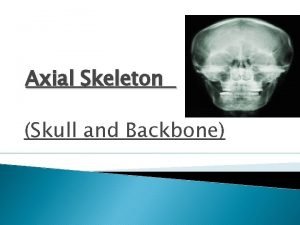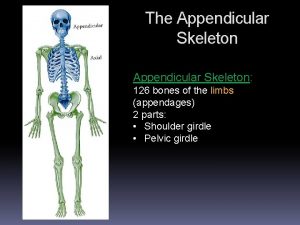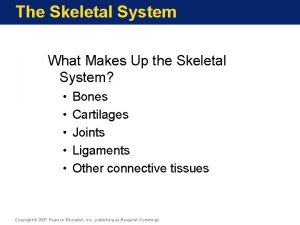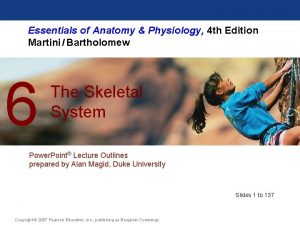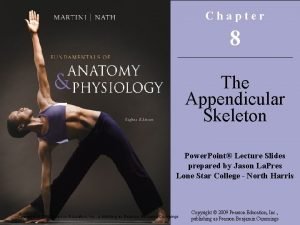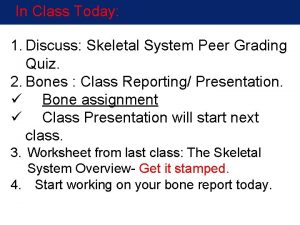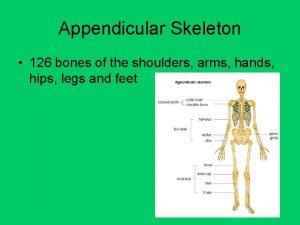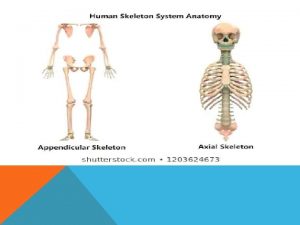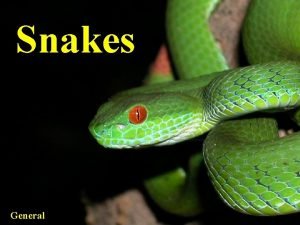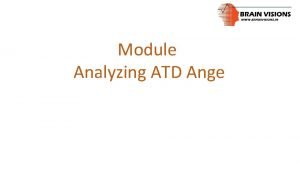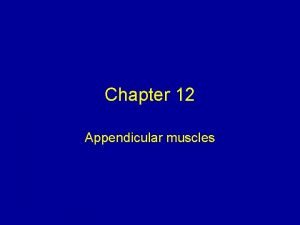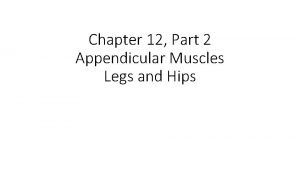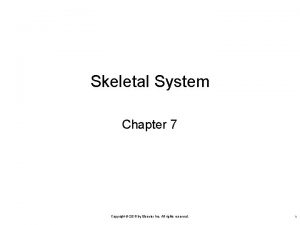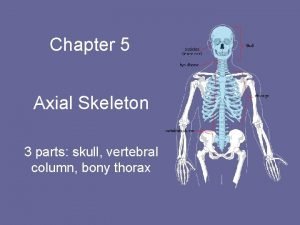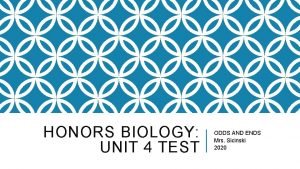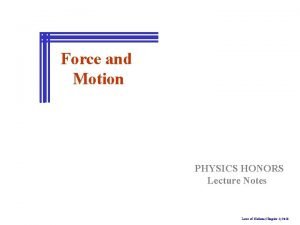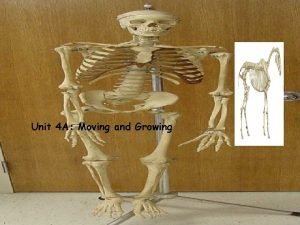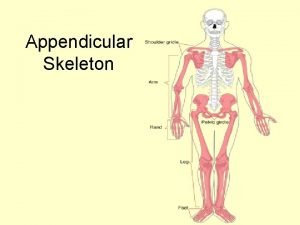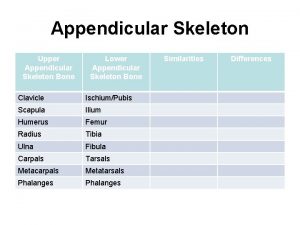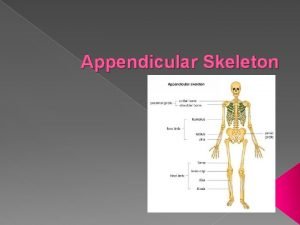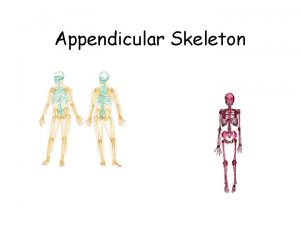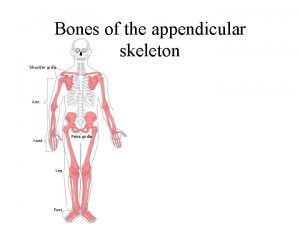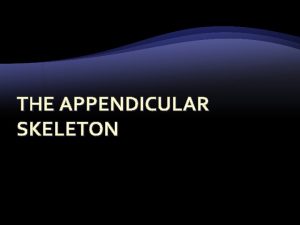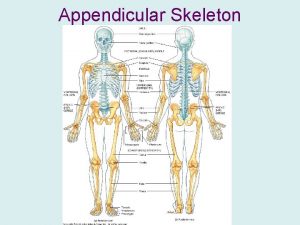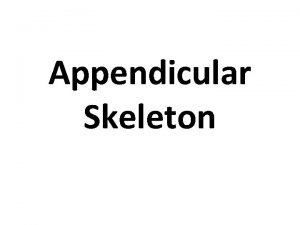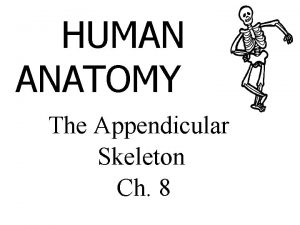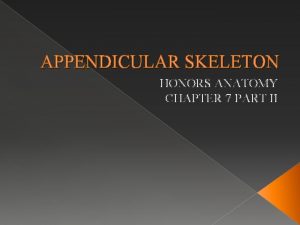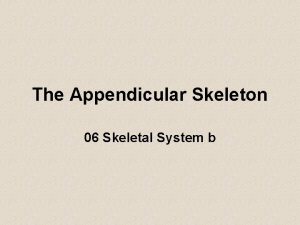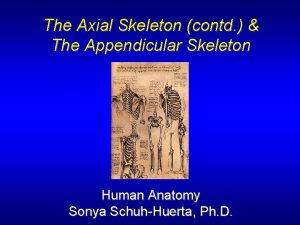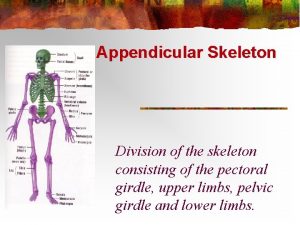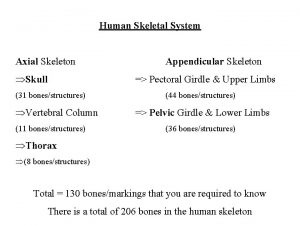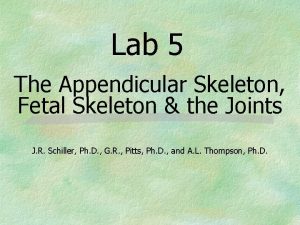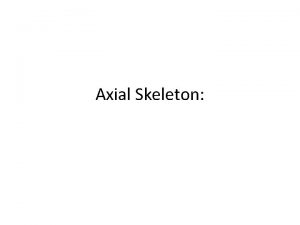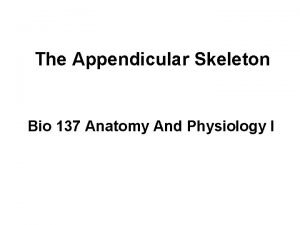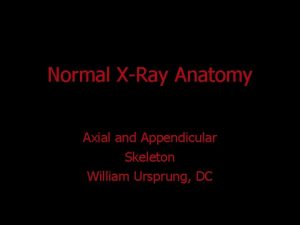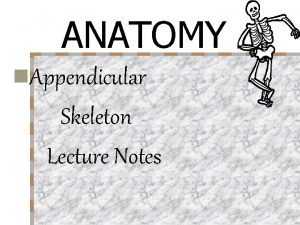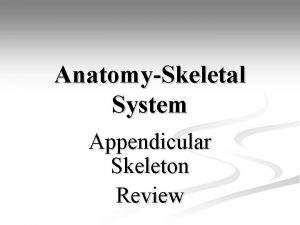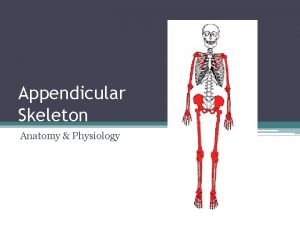APPENDICULAR SKELETON HONORS ANATOMY CHAPTER 7 PART II



































































- Slides: 67

APPENDICULAR SKELETON HONORS ANATOMY CHAPTER 7 PART II

The Appendicular Skeleton � Includes: limb bones 2. bones that connect limbs to axial skeleton 1. › › shoulder girdle pelvic girdle


The Pectoral Girdle (Shoulder) � 2 pectoral girdles � attach bones of upper limbs to axial skeleton � each: 1 clavicle � 1 scapula

Pectoral Girdle � does not form complete belt-like bony structure � anteriorly: clavicles attached to sternum � laterally: clavicles attach to scapulae � posteriorly: › scapula attach to vertebral column via muscle attahments


Clavicle � S-shaped, (medial ½ convex anteriorly, lateral ½ concave anteriorly) slender bone � lies horizontally across anterior thorax superior to 1 st rib

Clavicles � Functions: anchor muscles 2. hold upper limbs and scapula out laterally away from the narrow superior part of thoracic cage 1.

Clavicle � medial end = sternal end is rounded & articulates with the manubrium @ sternoclavicular joint

Clavicle � lateral end = acromial end is flat � articulates with acromion of the scapula to form acromialclavicular joint

Clavicle � last bone to stop growing � 1 of most frequently fx’d bones (2 curves) usually from fall on outstretched arm � or see compression fx in auto accidents from shoulder strap which can cause damage to median n. (between clavicle & 2 nd rib)

Scapula � aka shoulder blade, angel bone � large, triangular, flat bone � in superior part of posterior thorax between levels of 2 nd & 7 th ribs � spine: prominent ridge that runs diagonally across posterior surface

� lateral edge: acromion a flattened expanded process, easily felt as hi pt of shoulder (tailors use it as landmark to measure length of arm) � glenoid cavity: inferior to acromion, smooth, shallow depression that accepts head of humerus in shoulder joint

Scapula

Upper Limb � 1. 2. 3. 4. 5. 6. 6 parts: Humerus Ulna Radius Carpals Metacarpals Phalanges � � � Joints: Shoulder Elbow Wrist Hand

Humerus � longest & largest bone of upper limb � articulates proximally with scapula & distally with ulna & radius � head: rounded proximal end �articulates with glenoid cavity of scapula to form glenohumeral joint

Humerus

Humerus � distal end: � capitulum: rounded knob on lateral aspect that articulates with head of radius � trochlea: medial to capitulum, spool-shaped, articulates with ulna

Humerus

Forearm (Antebrachium) � 2 parallel bones: Ulna & Radius � articulate: › proximally with humerus elbow › distally with carpal bones wrist › with each other along their length radioulnar joint

Ulna � medial aspect of forearm › (in anatomical position: pinky finger side) � longer than radius � proximal end: olecranon (prominence in elbow) � distal end: head, styloid process (posterior)

Ulna

Radius lateral aspect of forearm � proximal end: head of radius: articulates with capitulum � distal end: styloid process (palpable proximal to thumb) �

Radius

Hand � includes: 1. Carpals › 2. Metacarpals › 3. wrist palm Phalanges › digits

Carpals proximal to the hand, distal to radius & ulna � 8 small bones joined by ligaments � articulations w/each other called intercarpal joints �

Carpal Tunnel

Metacarpals

Phalanges � 14 bones of the digits (each hand) � #’d I to V beginning with thumb � thumb is the pollex has only 2 phalanges, other digits have 3 � joints between phalanges called interphalangeal joints

Phalanges


Pelvic (Hip) Girdle � attaches lower limbs to axial skeleton › transmitting full weight of trunk to lower limbs � supports visceral organs of pelvic cavity � attachment to axial skeleton (compared to shoulder girdle) stronger via strongest ligaments in body

Pelvic Girdle � 2 hip bones (os coxa) which unite anteriorly at pubic symphysis and posteriorly with the sacrum @ sacroiliac joint

Pelvic Girdle Functions: � provides sturdy support for vertebral column � connects lower limb to axial skeleton �

Newborn Pelvis 3 bones on each side: 1. Ilium � › superior Pubis 2. › anterior & inferior Ischium � posterior & inferior 3.

Ilium � largest of the 3 hip bones � distinguishing features: 1. Iliac Crest � along superior surface (hands akimbo resting on them) 2. Sacroiliac Joint (SI Joint) � between sacrum and ilium

Ilium

Ischium � ramus of ischium fuses with pubis � distinguishing features: Ischial Tuberosity � what you feel when someone sits on your lap 1.

Ischium

Pubis � Pubic Symphysis › anterior joint between the 2 hip bones

Acetabulum � point of fusion of all 3 pelvic bones � a deep hemispherical socket

True Pelvis/ False Pelvis � Pelvic Brim: line that distinguishes between true & false pelvis

Male Pelvis � generally male bone heavier & stronger & have larger surface marker (because larger muscles attach) � Pelvis: › › deeper false pelvis, smaller, narrower pelvic brim heart-shaped acetabulum larger, faces posterior obturator foramen round

Female Pelvis � generally bones lighter & thinner � Pelvis: › › false pelvis shallow, widers pelvic brim larger, more oval acetabulum smaller & faces anterior obturator foramen oval

Male or Female?

Male or Female?

Lower Limb � carries the weight of the entire erect body � so bones are thicker & stronger than comparable bones in upper limb

Lower Limb � 30 bones in each: � 1 femur � 1 patella � 1 tibia � 1 fibula � 7 tarsals � 5 metatarsals � 14 phalanges

Femur � longest, heaviest, & strongest bone in the body � proximally articulates with the acetabulum to form hip joint › Head of the Femur: “ball” part of joint �small, central depression: fovea capitis › Greater Trochanter �prominence felt & seen @ side of hip

Femur: Proximal End

Femur: Distal End � broadens lateral & medial condyles › articulation points with tibia � each flanked superiorly: lateral & medial epicondyles › sites of muscle attachments


Femur � distally articulates with: › Patella › Tibia

Patella (kneecap) � small, triangular, sesamoid bone � develops in tendon of quadriceps femoris muscle � Parts: � Base: broad, superior end � Apex: pointed, inferior end

Patella

Tibia “shin bone” larger, medial, weight-bearing bone of lower leg proximally articulates with femur & fibula distally articulates with fibula & tarsals

Tibia � medial malleolus forms prominence that is palpable & visible on medial ankle

Fibula parallel & lateral to the tibia & considerably smaller � head of fibula on proximal end � lateral malleolus at distal end �

Tibia & Fibula � Interosseous membrane between tibia and fibula: is less flexible but more stable than radius and ulna

Foot � Functions: supports body weight 2. acts like a lever to propel body forward as we walk or run 1.

Tarsals � 7 bones: � 1 calcaneous: heel bone, largest of the tarsals

Metatarsals � 5 bones between tarsals & phalanges � #’d I to V from medial lateral

Phalanges 14 bones that make up the 5 digits � #’d I to V medial to lateral � Hallux: great or big toe has 2 large heavy phalanges �

Arches of the Foot � 2 arches in foot: 1. allows the foot to support weight of body by distributing weight over the soft & hard tissues 2. provide leverage while walking fully developed by age 12 - 13

Arches of the Foot � 2 longitudinal arches (medial & lateral � 1 transverse arch


 Axial vs appendicular skeleton
Axial vs appendicular skeleton Axial vs appendicular skeleton
Axial vs appendicular skeleton Sternocostal angle
Sternocostal angle 126 bones of the appendicular skeleton
126 bones of the appendicular skeleton Difference between axial and appendicular skeleton
Difference between axial and appendicular skeleton Figure 6-4 the skeleton axial and appendicular divisions
Figure 6-4 the skeleton axial and appendicular divisions Structural and functional classification of joints
Structural and functional classification of joints Figure 6-4 the skeleton axial and appendicular divisions
Figure 6-4 the skeleton axial and appendicular divisions Linea aspera
Linea aspera Figure 6-4 the skeleton axial and appendicular divisions
Figure 6-4 the skeleton axial and appendicular divisions Axial skull
Axial skull Anterior surface of scapula
Anterior surface of scapula 126 appendicular bones
126 appendicular bones Labeling appendicular skeleton
Labeling appendicular skeleton Skeletal system
Skeletal system Snake anatomy
Snake anatomy Chapter 3 geometry test
Chapter 3 geometry test Precalculus honors chapter 1 test
Precalculus honors chapter 1 test Axial triradius
Axial triradius Semitendonosis
Semitendonosis Appendicular muscle
Appendicular muscle Appendicular
Appendicular Flegmonous
Flegmonous 7:4 skeletal system
7:4 skeletal system Chapter 7:4 skeletal system label the skeleton
Chapter 7:4 skeletal system label the skeleton Receive
Receive Creighton honors program
Creighton honors program Aces james scholar
Aces james scholar Deped order no. 36, s. 2016
Deped order no. 36, s. 2016 Duels ucsb
Duels ucsb Physics semester 1 review
Physics semester 1 review Honors biology ecology test
Honors biology ecology test Economics 4.05 uncle sam's toolbox honors
Economics 4.05 uncle sam's toolbox honors Quadrilateral test review
Quadrilateral test review Honors earth science
Honors earth science Kuei honors chemistry
Kuei honors chemistry Mrs blueprint
Mrs blueprint Hilton honors military program
Hilton honors military program Honors project
Honors project Honors biology properties of water lab
Honors biology properties of water lab Honors geometry parallel lines and transversals worksheet
Honors geometry parallel lines and transversals worksheet Tulane honors program
Tulane honors program Honors physics projectile motion test
Honors physics projectile motion test Honors biology unit 4 test
Honors biology unit 4 test Santa monica college honors program
Santa monica college honors program Chemistry unit 4 review answer key
Chemistry unit 4 review answer key Golden opulence sundae
Golden opulence sundae Math 3 honors
Math 3 honors Crystalline solid and amorphous solid
Crystalline solid and amorphous solid Honors chemistry summer assignment
Honors chemistry summer assignment Stlucieschools skyward
Stlucieschools skyward Mahurin honors college
Mahurin honors college No3 polarity
No3 polarity Honors algebra 2 final exam
Honors algebra 2 final exam Umes honors program
Umes honors program Latin honors smith college
Latin honors smith college What is the earth's nearest celestial neighbor
What is the earth's nearest celestial neighbor Physics honors notes
Physics honors notes Part whole model subtraction
Part whole model subtraction Part to part ratio definition
Part to part ratio definition Brainpop ratios
Brainpop ratios What is technical description
What is technical description Bardie and speed rail are part of front bar
Bardie and speed rail are part of front bar The phase of the moon you see depends on ______.
The phase of the moon you see depends on ______. 미니탭 gage r&r 해석
미니탭 gage r&r 해석 Moving and growing
Moving and growing Sue palmer skeleton writing frames
Sue palmer skeleton writing frames Demon stabbing heart flag
Demon stabbing heart flag

